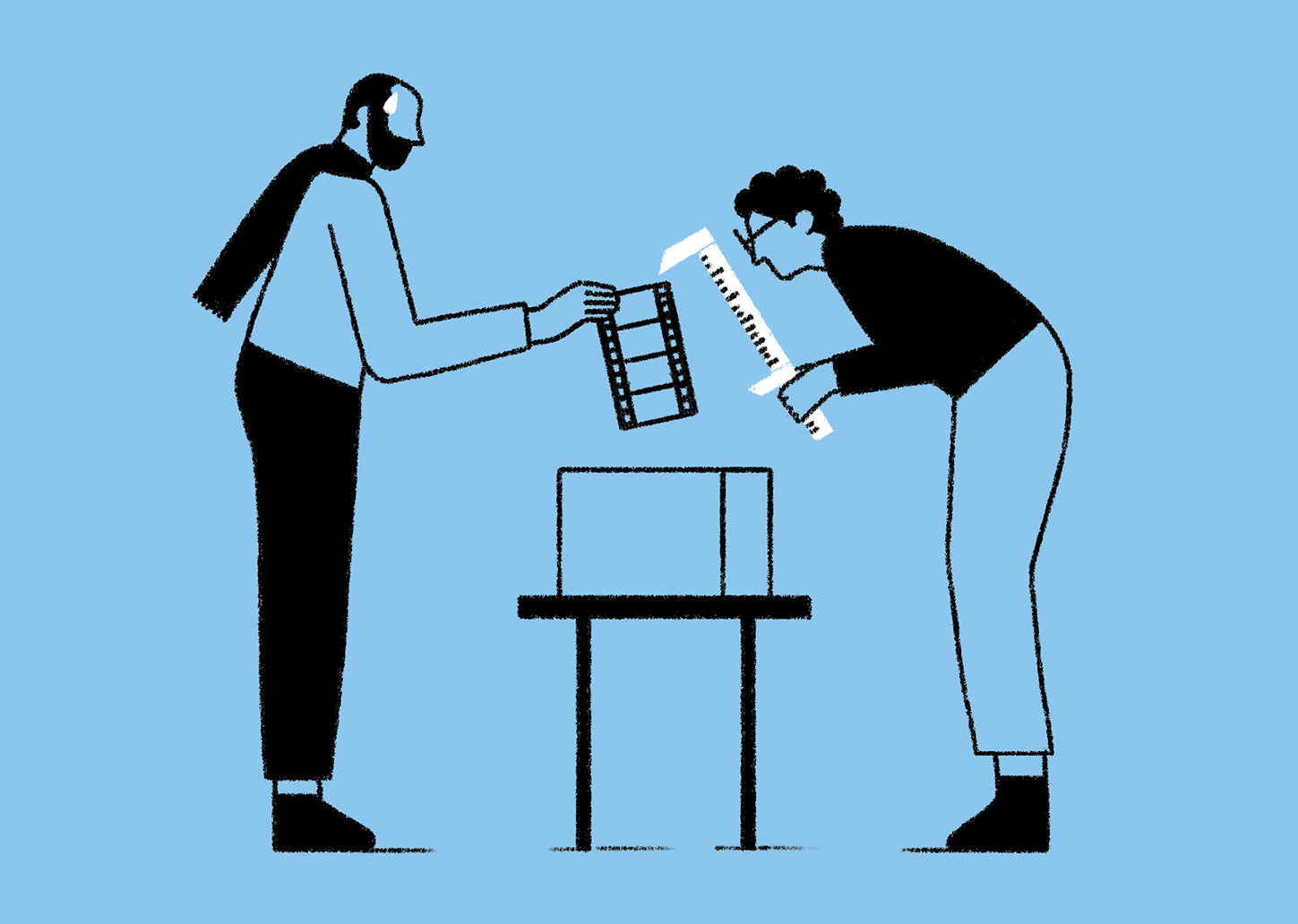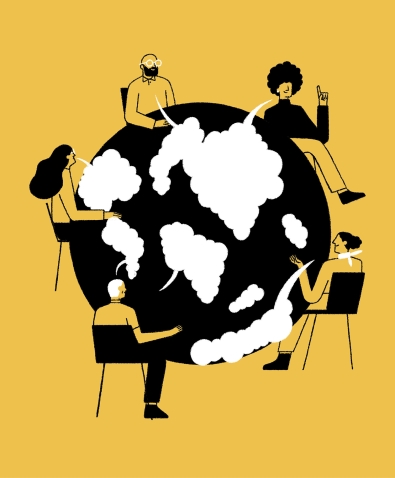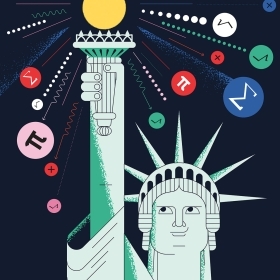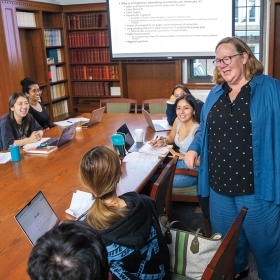The hottest July on record on planet Earth, continued reckoning with racial injustice and gender inequity, political polarization in the United States and around the globe, anxiety about artificial intelligence—there are plenty of problems in the world right now. We asked faculty and researchers from around the College for their big ideas for solving a problem related to their field, if time and money were not constraints. They came back with creative, interdisciplinary, and surprising ideas, finding inspiration in far-ranging places—medieval concepts of chivalry, an environmental advocacy group in Miami, Okla., what social science says about decision-making, and, of course, Wellesley students.
Wellesley classrooms are a natural incubator for big ideas. Codruţa Morari, associate professor of cinema and media studies at Wellesley, says she loves teaching at a liberal arts college because students are open to conversations about complex problems. “I wouldn’t be doing what I am doing if I did not believe that looking at history with a critical lens teaches us something about what we can do to change the future,” she told us. Read on to learn how these scholars would change the world for the better.
Look to Youth as Architects of a Safer Digital World
Linda Charmaraman is a senior research scientist at the Wellesley Centers for Women and director of the Youth, Media & Wellbeing Research Lab.
There is much hand-wringing about how to protect children and teens from online predators, bullies, advertisers, and biased algorithms that take them down rabbit holes. What if instead of trying to shield young people from these external forces, we looked to them for solutions? They are the experts on the digital ecosystems they inhabit and are the key to understanding how, why, when, and with whom they build their character, identity, and online personae.
What would centering youth look like? We could put them in the technology design room to help develop social media algorithms that lead to healthy interactions online. We could ask them to design marketing campaigns that actively foster community and self-compassion online rather than passive consumerism, eating disorders, and FOMO. We could bring them on as advisory council members in digital citizenship programs in schools—even turning the tables by guiding parents on navigating digital connections. In education, health care, policy-making, and Silicon Valley, young people could be the ones who realize the promise of social media: connecting people in ways that create lifelines, particularly for those who are marginalized and depend on the communities they find online.
This requires a shift in our thinking about youth and social media. Rather than have adults serving as the creators and gatekeepers of these digital worlds, why not put youth in the driver’s seat? There’s no limit to what they can accomplish when they are empowered to make proactive change, harnessing their expertise and hope to make a difference in this world.
Demand More Transparency From Film Festivals
Codruţa Morari is an associate professor of cinema and media studies. She is writing a book about the impact of U.S.-based streaming services on European media industries.
At the 76th Cannes Film Festival in May, French filmmaker Justine Triet won the Palme d’Or for her courtroom drama Anatomy of a Fall. Triet was just the third woman director to win the award in the festival’s history.
In presenting the award, actor and activist Jane Fonda commented on how far women have come in the industry. In 2023, seven of the 21 films in competition for the Palme d’Or were directed by women. Thirty percent is an improvement, but it’s not parity.
To foster gender equity, big art festivals should diversify their programming teams and selection committees. How did Cannes go from the 2,000 films they received to the list of 21 that were selected? What criteria are being used? The lack of transparency has created a club culture around the process that hurts marginalized voices.
While recognition at film festivals can increase filmmakers’ visibility and viability on the international market, it does not guarantee success. In 2019, French Senegalese filmmaker Mati Diop made history at Cannes with her debut, Atlantics, when she became the first Black woman to direct a film featured in competition. But its impact in the U.S. was muffled after it was picked up for distribution by Netflix—it was never screened in theaters, and because the streamer doesn’t release viewership data, it’s hard to know what kind of reach it’s had since the festival.
Interestingly, at Cannes this year I saw many women filmmakers from countries with smaller film industries, like Mongolia, Indonesia, Georgia, and North African nations. These markets have space, both aesthetically and economically, for more experimental films. I’d like to see that ethos spread more widely, and for the community to rearticulate the place of media and film in our culture and our society. Is it just Netflix and chill, or does film have a purpose beyond that?

Strengthen Democracy Through Ranked Choice Voting
Ismar Volić is a professor of mathematics and the director of the Institute for Mathematics and Democracy. His book Making Democracy Count: How Mathematics Improves Voting, Electoral Maps, and Representation comes out in 2024.
The familiar plurality or winner-takes-all voting system, in which voters choose their top candidate, can lead to issues like vote-splitting and spoilers. Ranked choice more accurately reflects voters’ preferences.
In the historic 2021 Boston mayoral election, for example, 95% of voters supported a woman of color in the preliminary round. However, two Black women candidates, Andrea Campbell and Kim Janey, likely split the vote. Ranked choice voting could have allowed Campbell or Janey to proceed to the runoff, ensuring a more representative outcome.
Plurality’s problems are magnified in multi-winner elections, where a bloc of voters can dominate the outcome. This happened in Lowell, Mass., where Asian and Latino candidates were shut out of city council and school committee representation because of bloc voting by white voters. (Lowell changed its voting system after it was sued.) Easy incumbency victories are another side effect, as the bar for unseating someone with name recognition is dauntingly high.
Ranked choice’s strength lies in allowing voters to rank multiple candidates. If no candidate secures a majority, the candidate with the fewest first-place votes is eliminated, and their votes are transferred to the next choice on each ballot. This process continues until a majority winner emerges, capturing voter preferences more comprehensively. The system curbs vote-splitting, prevents wasted votes, and eliminates the need for costly runoffs.
A ranked choice voting ballot initiative in Massachusetts was defeated in 2020 because the pandemic interfered with educating voters about the issue, but a new coalition hopes to bring the system to the City of Boston’s elections. And more than 90 municipalities in 27 states are putting ranked choice voting on the ballot in 2023 or 2024—an encouraging step toward fixing our mathematically flawed democracy.
Empower Survivors of Intimate Partner Violence Through Vocational Training
Pinar Keskin is an associate professor of economics. She also serves as a research fellow at the Women and Public Policy Program at Harvard Kennedy School.
Intimate partner violence is a widespread problem that goes beyond borders, affecting people from all walks of life. In developing countries, this issue gets even worse due to limited resources, cultural norms, and inadequate support systems. Those experiencing intimate partner violence often can’t break free due to financial dependency, leading to ongoing cycles of abuse.
This is why well-equipped shelters that offer temporary accommodation, counseling, and legal support for victims are so important. But with enough funding, there’s a chance to do more—by creating vocational training programs designed specifically for the shelter residents. These programs would cover various areas, from hands-on trades like carpentry and tailoring to modern skills like tech and entrepreneurship. And it’s not just about learning the vocations; these programs would also teach important life skills like communication, leadership, and financial literacy to empower survivors.
Securing necessary funds matters, but governments, NGOs, and local communities also need to collaborate to keep these programs going.Governments can integrate them into social support systems, NGOs can provide their know-how in program design and delivery, and communities can play a pivotal role in raising awareness, promoting acceptance, and supporting survivors as they transition into new economic roles.
This job training isn’t just about money. When survivors gain financial independence, it creates a domino effect of change. They become role models, inspiring others to leave abusive relationships. As more people gain independence, society starts rethinking old ideas about gender roles, slowly breaking down the reasons behind the persistence of intimate partner violence.
Take a Crude Look at the Whole to Solve Wicked Problems
Dan Brabander, professor of geosciences and environmental studies, offers “Big Idea” courses that introduce systems thinking in applied and messy problem spaces.
The dramatic decrease in the severity and frequency of childhood lead poisoning in the U.S., thanks to the passage of laws in the 1970s regarding lead, is often painted as a problem solved. And the mean blood lead level of the U.S. population did drop by 78% from the 1970s to the early ’90s.
But in my classes, students quickly learn about the “tyranny of the average”—the idea that using an average to predict a trend is easy, but it’s also lazy and often wrong. The national average masks the serious problems of many communities in the U.S., like those surrounding the Tar Creek Superfund Site in Ottawa County, Okla., which have been contaminated by mine waste piles, and where my lab collaborates with LEAD Agency, a local environmental advocacy group.
In my work in the emerging field of geohealth, which sits at the intersection of public and environmental health and geosciences, I advocate for a systems approach to solving wicked problems like how to create a safe, livable community in the Tar Creek floodplain. This begins with taking a “crude look at the whole,” as Nobelist Murray Gell-Mann, a physicist, put it. It involves learning enough of the technical language of other disciplines so that the right questions can be co-discovered with collaborators. It also means not privileging one type of systems knowledge over another (say, quantitative over the lived experiences of those in the floodplain).
There’s risk in this approach—it can be challenging to get funding, and it requires principal investigators to give up some control. But in this messy work, there is also beauty, and a greater chance of unexpected discoveries.
Teach Future Engineers to Consider the Ethical Implications of Their Work
Eni Mustafaraj is an associate professor of computer science. Julie Walsh is an associate professor of philosophy and co-director of the Suzy Newhouse Center for the Humanities.
Is the person who programs a self-driving car responsible for it crashing? What are the ethics of augmenting human bodies with digital tech? Are technologists obligated to consider the impact their employers have on local communities, like rising housing costs in Silicon Valley?
We are faculty in the philosophy and computer science departments who have frequently guest lectured in each others’ classes, and these are just a few of the questions we’ve fielded from students over the years. They are hungry for these conversations, and they’re already asking all the right, hard questions. What they don’t yet have is an intellectual infrastructure that can help them figure out their position on these questions.
That’s why we developed CS 334/PHIL 322: Methods for Ethics of Technology, a course we began teaching this semester. Our students are learning theoretical frameworks from both our fields to help them approach the ethical issues that come with digital technologies and empower them to find creative solutions. Supported by a $400,000 grant from the National Science Foundation, and with help from our research associate CJ Larkin ’22, the class is also engaging with Wellesley alums through surveys and interviews to learn how Wellesley prepared them to think ethically and how alums have navigated ethical quandaries in the workplace.
Our long-term vision is to turn Wellesley into a leader in issues of ethics and equity in digital technology, especially with respect to the areas of concern for women and other groups that experience systemic bias and harm. We hope to give students the tools to discover who they are and to help shape the tech industry for the better.

Today’s Anti-Racists Should Marshal Chivalric Language
Cord J. Whitaker is an associate professor of English and a consultant on anti-racist communications strategies at Sagely. He is the author of Black Metaphors: How Modern Racism Emerged from Medieval Race-Thinking.
In 2020, during the height of the Black Lives Matter protests in the wake of George Floyd’s murder at the hands of police, I wrote in Politico about how white supremacists support their cause with chivalric language and that anti-racists should, too. Using the language of honor to claim that you are defending those in need of defense is a power move in our U.S. culture long obsessed with the idea that there are good guys and there are bad guys.
In 2023, events continue to unfold that demonstrate the value of chivalric language in the politics of race. In August, the U.S. suffered another in its long string of racist killings. A lone gunman targeted the historically Black Edward Waters University in Florida. When a security guard took notice, the shooter left the campus and instead targeted a Dollar General store down the street. He fired on and killed three people. All of his victims were Black.
The mourners of this and other racist killings openly recognize that racist attacks are encouraged by political rhetoric that targets critical race theory (CRT)—the study of racism’s systemic effects—and Black history. That rhetoric is usually couched in the language of defense. Florida Gov. Ron DeSantis’s crusade against CRT claims that teaching about racism makes white children feel bad. Defenseless children must be defended. The Ku Klux Klan fashioned itself as knights defending the defenseless, too.
But who could be more in need of defense than people who may be shot to death just for being Black and going to college or the dollar store? In the early 20th century, Black thinkers and artists, especially those associated with the Harlem Renaissance, recognized and experimented with Black chivalry. Yet, these days, the chivalric language of defense is not often marshaled by antiracists and Black communities. Its power means that it should be.
Focus On Systems Over Individuals
Elizabeth DeSombre is the Camilla Chandler Frost Professor of Environmental Studies. She is spending the year as a fellow at the Center for Advanced Study in the Behavioral Sciences at Stanford University.
I teach environmental politics because I want us to be wise in the ways we choose to tackle environmental problems. I’ve seen too many students and other activists dispirited when their efforts to simply tell people the right way to behave environmentally fail to achieve the change they hope for.
Even those who do want to change their behaviors are stymied by psychological and practical factors. Making environmentally friendly choices involves emotional and practical effort. They can also backfire when people “reward” themselves for good environmental behavior by relaxing their standards elsewhere. Individuals can struggle if the systems around them aren’t supportive—if there isn’t public transportation near them, for example. And, ultimately, individually persuading people to change their behavior isn’t nearly efficient enough to create the change we need.
Shifting behaviors into systems has a far greater impact. Systems can happen at any level—from national policies to zero-waste events to creating personal habits. Even simple things like changing defaults can have a big effect. Some towns, for example, have made renewable energy sources the default for electricity customers; if customers want cheaper nonrenewable energy, they need to make the effort to opt out.
Any time I’m trying to do something good for the environment and run into a roadblock, rather than just solve it for myself, I try to figure out what system change I can make to solve the problem for others. Even if it’s as simple as putting up a sign once I’ve located the compost bin in my new apartment building to tell others where it is.









We ask that those who engage in Wellesley magazine's online community act with honesty, integrity, and respect. (Remember the honor code, alums?) We reserve the right to remove comments by impersonators or comments that are not civil and relevant to the subject at hand. By posting here, you are permitting Wellesley magazine to edit and republish your comment in all media. Please remember that all posts are public.